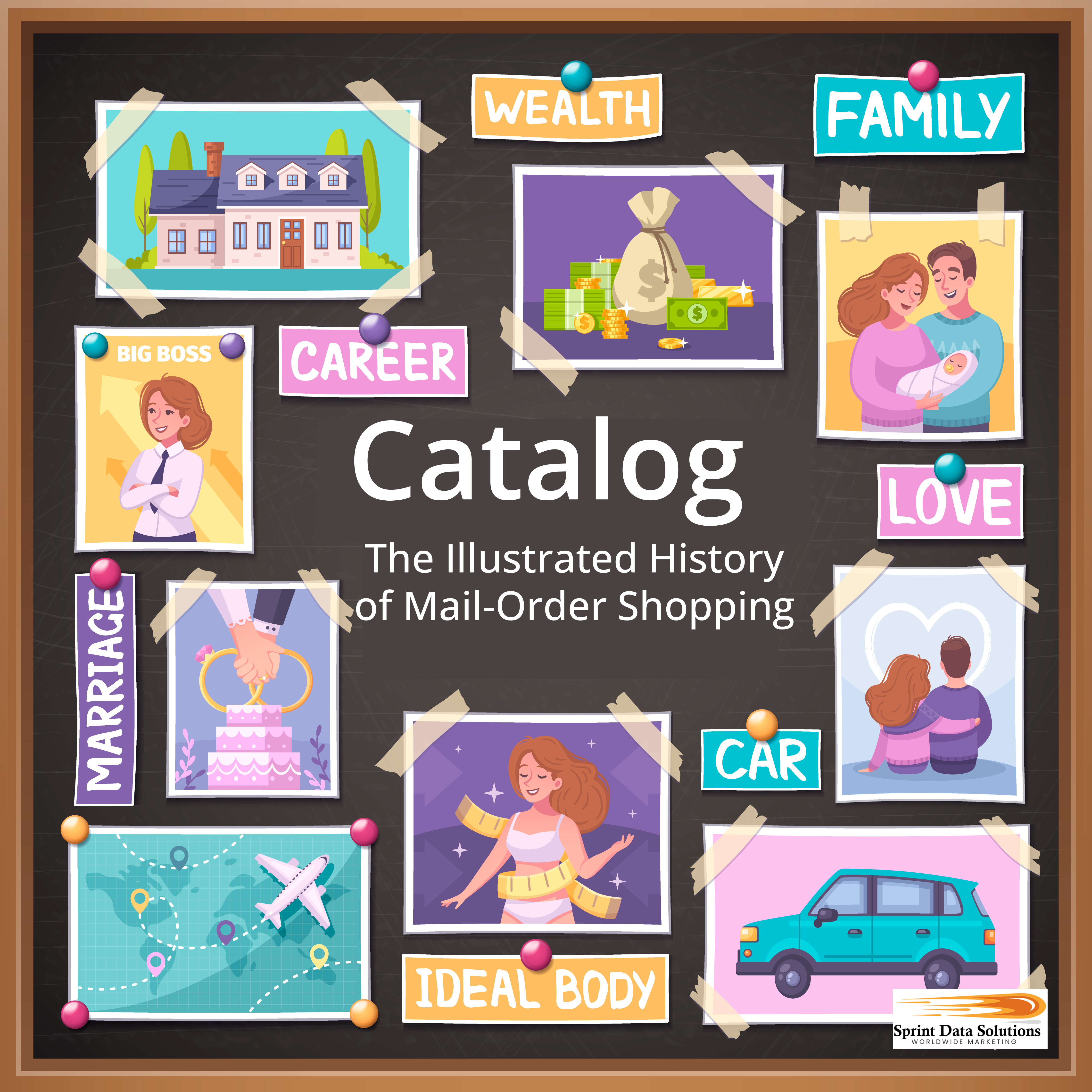Catalog & Magazine Mailing List
The 21st century has brought significant transformations to traditional consumer habits. Shopping, once a familiar activity for generations of Americans, took place in physical locations like markets or shopping malls, where people would buy goods in person. However, today, much of the world, including America, has embraced the convenience of digital shopping through websites. Despite this rapid shift, the catalog—a once-dominant marketing tool in print—remains surprisingly relevant, even in this digital age.
While online shopping has become a central part of modern commerce, catalogs continue to hold an important place in marketing strategies. The catalog, once a print staple, laid the groundwork for how products are organized on today’s retail websites, offering structured listings and detailed descriptions. This format remains valuable, especially when paired with other traditional media, such as print flyers and magazines, which still hold appeal for certain consumer segments. For businesses targeting these catalog and magazine-engaged audiences, Sprint Data Solutions Worldwide Marketing provides expert services to help reach these valuable markets effectively.
The Sprint Data Solutions Worldwide Marketing Story
Sprint Data Solutions Worldwide Marketing is a proudly American company, founded and operated by a disabled veteran. After fulfilling his service to the nation, the decision was made to shift focus from defense to fostering economic growth. The founder’s vision was to create a business that would empower the American business community to expand and thrive. This vision led to the establishment of Sprint Data Solutions Worldwide Marketing, which began its operations in the vibrant and entrepreneurial hub of Las Vegas, Nevada.
Over the years, the company has experienced consistent growth and success, driven by its commitment to quality service and innovation in marketing strategies. Today, Sprint Data Solutions Worldwide Marketing stands as a trusted leader in its industry, with a management team that boasts more than 50 years of combined expertise in marketing and sales. This wealth of experience, paired with an unwavering commitment to helping businesses succeed, has allowed the company to serve clients effectively across various sectors, fostering long-term relationships and contributing to the growth of businesses both locally and internationally.
At the onset of Sprint Data Solutions Worldwide Marketing’s operations, the landscape of advertising was still predominantly analog, with traditional platforms like print and television ads taking the lead. Recognizing the potential in this environment, the company chose to specialize in print marketing, specifically direct mail, which was a dominant form of outreach at the time. Over the years, despite the rise of digital platforms, direct mail remained a reliable and highly effective marketing tool, continuing to play a significant role in Sprint Data Solutions Worldwide Marketing’s strategies today.
As the company’s success grew, it recognized the need to expand its services and broaden its reach. What began as a regional operation in Las Vegas, Nevada, eventually grew to serve the entire United States, including Hawaii and Alaska. The company continued its expansion, offering full North American coverage, including targeted services for Mexico and Canada. With a keen focus on global opportunities, Sprint Data Solutions Worldwide Marketing extended its offerings internationally, tapping into European Union markets such as France. Throughout this journey, direct mail remained the company’s core offering. However, as digital technologies advanced, the company evolved by integrating digital marketing services to meet the demands of an increasingly online consumer base. Today, Sprint Data Solutions Worldwide Marketing is well-positioned to serve both traditional and digital marketing needs, continuing to help clients reach their target audiences across multiple platforms and markets.

The Catalog & Magazine Advantage
Despite the digital revolution, catalogs and magazines, as tangible physical items, still have a special charm and appeal—especially when crafted with care and attention to detail. These traditional formats have not been rendered obsolete by online shopping services; rather, they have evolved to complement digital retailing, adding an extra layer of utility. In the past, catalogs required customers to either visit a physical store to pick up their chosen items or send in a mail-order form. Additionally, phone calls were sometimes used to complete the purchase process.
Today, magazines offer a similar kind of appeal. A well-produced magazine can captivate attention in ways that websites cannot. With the dedicated work of skilled editorial teams and graphic designers, print magazines often have a quality that surpasses the rapidly created content on many websites. More importantly, magazines don’t require an internet connection to be enjoyed, giving them an advantage over digital formats.
When used strategically, catalogs and magazines offer businesses the opportunity to stand out and bypass the clutter of busy email inboxes, providing a more tangible and memorable experience. Their effectiveness lies in their ability to deliver content in a way that feels more personal and immersive than digital methods, without relying on an internet connection. However, when customers are ready to make a purchase, these traditional mediums seamlessly integrate with modern technology. A quick phone call or the convenience of an internet-connected device allows businesses to accept orders swiftly, making catalogs and magazines especially useful for businesses such as those in retail, luxury products, travel, or any industry looking to connect with customers in a more engaging and direct manner. This can be useful for businesses such as:
Home Cooking Magazines
The pandemic had a profound impact on many aspects of daily life, including dining habits. With lockdowns and restrictions in place, people became more accustomed to preparing meals at home, which in many cases has persisted even as restrictions have eased. Many consumers now view cooking at home as a more economical choice, particularly when managing monthly budgets, as dining out less frequently has become a preferred way to save money.
In this evolving landscape, cooking magazines continue to play a significant role. Unlike digital devices such as phones or tablets, which may be prone to distractions or difficult to use in a messy kitchen environment, magazines offer a tactile, accessible, and safer alternative. They are designed to be used easily during meal preparation, allowing home cooks to follow recipes without the risk of screen smudges or interruptions. These magazines provide an enduring appeal for consumers seeking reliable, hands-on resources for culinary inspiration and practical meal planning. For businesses aiming to engage with this audience, partnering with targeted cooking publications remains an effective marketing strategy.
Fine Wines
Wine is more than just a beverage; for many, it’s a passion, a hobby, and in some cases, even a valuable investment. Wine holds a distinct cultural and sophisticated place in the lives of enthusiasts, making magazines and catalogs focused on wine highly relevant and sought after by this demographic. To captivate wine lovers, it’s not enough to simply showcase wines—marketing efforts must also incorporate rich, knowledgeable content that explores wine culture, history, and trends.
Wine marketing spans a wide spectrum of economic categories, from affordable table wines for casual enjoyment to rare, high-quality bottles from prestigious vineyards, each catering to different tastes and occasions. Specialty wines, such as ice wine, are often featured as part of celebrations or to mark significant events, adding another layer of appeal. Given the centuries-old legacy of wine, publications in this niche can offer a mix of educational content, insights into the latest industry trends, and stories behind each wine’s heritage. For businesses looking to tap into this refined market, it’s essential to pair their products with expertise, storytelling, and a deep understanding of the cultural significance that wine holds for its aficionados.

Cigars
Much like wine, cigars are often regarded as a premium luxury item, associated with leisure, relaxation, and special occasions. While cigars, like wine, are considered an acquired taste, their rich history and passionate following have endured for centuries, despite the modern health warnings that accompany them. Unlike cigarettes, cigars are typically consumed less frequently, elevating them to a more ceremonial status for many enthusiasts.
Similar to wine, cigars are consumables, and once the current stock is enjoyed, there’s always a demand for replenishment. This creates opportunities for both loyalty and experimentation with new varieties. Proper marketing and presentation are crucial, as cigars often appeal to connoisseurs looking for unique flavors and experiences. With the right educational and informational materials, businesses can effectively promote specific cigars, highlighting their distinctive qualities and craftsmanship. By targeting the right audience—cigar enthusiasts and collectors—companies can create compelling marketing campaigns that drive both engagement and sales.
Household Goods
Homes rely on a wide array of products to function efficiently, ranging from everyday essentials like dishwashing soap and toilet paper to more specialized items such as winter sidewalk salt or tools for home maintenance. Each room in the house demands its own set of products to ensure things run smoothly. Catalogs have long been an excellent resource for showcasing these diverse products, offering consumers a comprehensive view of what’s available to meet their needs. Magazines, on the other hand, serve as a valuable guide, not only highlighting the best products but also providing expert tips, techniques, and advice on how to maintain and improve various aspects of the home. Whether it’s recommending time-saving cleaning solutions or offering seasonal home care tips, these publications continue to play a vital role in helping homeowners make informed decisions about their purchases and maintain their living spaces in optimal condition.
Children’s Products
The market for children’s products has long been vast and diverse, encompassing a wide range of categories from educational tools and services to nutrition, entertainment, and safety. As the demand for products that enhance the development, well-being, and enjoyment of children continues to grow, catalogs offering these goods have also become increasingly varied. However, children’s magazines provide a unique and powerful platform for reaching parents with the latest products and services designed to improve the child-rearing experience.
Parents are always on the lookout for innovative solutions to support their children’s growth, whether it’s through educational materials, toys, or health-related products. Magazines targeting this demographic offer a direct way to present new ideas and products to receptive audiences. By leveraging the influence of these publications, businesses can tap into an engaged market eager to discover products that will help them raise their children more effectively. For companies seeking to connect with parents and caregivers, catalogs and children’s magazines remain a vital channel in the marketing landscape.
CBD Oil & CBD Creams
As various states across the United States continue to update the legal status of cannabis, CBD, a non-intoxicating by-product of cannabis, has quickly gained recognition for its potential therapeutic benefits. CBD has been found to help alleviate stress, manage pain, and support digestive health in both humans and animals. Unlike THC, the active compound in cannabis responsible for a high, CBD does not have intoxicating effects, making it an appealing option for a wide range of consumers seeking natural remedies.
Marketing CBD oil and other CBD-based products requires targeting the right audience with tailored messaging. For example, seniors are increasingly turning to CBD oil as a solution for chronic pain management, making this demographic a key market for CBD products. In contrast, athletes often use topical CBD creams to relieve muscle aches and inflammation after strenuous physical activity. These two customer groups represent very different needs and approaches to CBD use, highlighting the importance of creating targeted marketing strategies that resonate with specific consumer preferences. Catalogs and magazines serve as ideal platforms for reaching these diverse audiences with product information, educational content, and promotional offers designed to meet their unique needs.
Sports Magazines & Products
Sports have long been a central theme in print media, with magazines dedicated to covering various aspects of the industry, from athletes to sporting events. This demand for in-depth information about both mainstream sports like basketball and more niche activities like bobsledding remains strong, as fans seek out continuous updates, insights, and expert analysis. The desire for specialized content keeps these publications thriving, with enthusiasts relying on them for comprehensive details about their favorite sports, teams, and players.
Equally important, the demand for sporting products is ever-present, and magazines or catalogs showcasing the latest gear and equipment remain essential to the market. Whether it’s cutting-edge basketball shoes, the latest in football protective equipment, or specialized accessories for unique sports, accurate and well-curated catalogs serve as vital tools for both consumers and businesses. The key is aligning the right products with the right sports magazines and targeting the specific enthusiasts who are most likely to make informed purchasing decisions. By understanding these dynamics and tailoring offerings accordingly, businesses can effectively engage with dedicated sports fans and drive sustained demand for sporting products.
Seeds & Plants
Gardening has long been an integral part of American home life, with its benefits extending beyond the beauty of green spaces to include environmental impact and cost savings. In recent years, there has been a resurgence in interest as more people seek to live sustainably and reduce their grocery bills by growing their own food. This renewed focus on eco-friendly practices has made seeds, plants, and gardening supplies more popular than ever.
Today, there are a wide range of products and services available for gardeners, catering to everyone from first-time hobbyists to seasoned green thumbs. Beginners may seek basic seeds, soil, and tools, while more experienced gardeners are likely interested in advanced products like specialty seeds, soil amendments, hydroponic systems, or unique plants. Additionally, a variety of gardening techniques—from organic methods to vertical farming—can help enthusiasts of all skill levels enhance their gardening experience. For businesses in the gardening industry, targeting these diverse needs presents a valuable opportunity for growth and customer engagement.
Collectibles
A substantial and diverse segment of consumers is passionate about collectibles, yet their interests vary greatly depending on the category. For instance, there is a significant distinction between individuals who collect stamps and those who are dedicated vinyl enthusiasts, acquiring both new and vintage music pressings. The same divergence exists between collectors of vintage video game hardware and software from the 1980s and 1990s, known as retro gamers. Each of these groups not only has distinct tastes but also different purchasing habits, making it essential for marketers to tailor their strategies.
As a result, catalogs and magazines targeting collectible markets must prioritize specificity to avoid alienating potential customers. A catalog focused on stamps will hold little appeal to a retro gamer, just as a magazine about retro gaming will not attract a vinyl collector. However, when targeted marketing materials are correctly matched to the interests of the right collector, the response rate is significantly higher. This precise targeting fosters increased engagement, stronger customer loyalty, and ultimately higher conversion rates for businesses looking to tap into these niche markets. Proper segmentation of the collectibles market is crucial for successful campaigns and long-term growth.

Clothing & Fashion
Clothing has long been a prominent category in both catalogs and retail, remaining one of the most significant items for purchase through direct mail and online channels. Despite the evolution of shopping habits, clothing continues to account for a large share of both catalog and online sales. For Sprint Data Catalog Mail Order buyers and responders, fashion and apparel are consistently popular, though the specific types of clothing purchased often vary widely based on individual customer preferences and needs.
Professional attire, for instance, tends to be purchased more for its practicality, durability, and protective features rather than purely for fashion. This trend reflects a broader shift in consumer behavior, where the function of clothing often outweighs its aesthetic appeal, especially in work environments that demand resilience and comfort.
However, one constant in the success of clothing sales, whether in catalogs, magazines, or online platforms, is the importance of high-quality imagery. Clothing items thrive in marketing materials when paired with well-crafted photography that highlights the texture, fit, and appeal of the garments. When combined with engaging, informative content about the clothing—whether focused on style tips, usage scenarios, or the clothing’s durability—apparel consistently performs well in both traditional catalog formats and modern digital campaigns. Proper presentation and a thoughtful approach to showcasing the items can make clothing a top seller across various platforms, ensuring continued success for businesses in this category.
Home Improvement
Working with professionals typically results in high-quality home improvement and renovation projects, but it often requires a significant investment. This is one of the key reasons why the “Do It Yourself” (DIY) approach remains a popular and accessible alternative for many homeowners. For businesses offering home improvement products or services, directly engaging with the consumer can be highly profitable, provided they can effectively reach and connect with the right audience.
Homeowners are continually faced with projects—whether it’s a minor repair, a major renovation, or a full-scale remodeling—that can improve their living space. When done correctly, these upgrades not only enhance the functionality and aesthetic appeal of a home but can also increase its market value. The home improvement industry is diverse, with countless opportunities for businesses to tap into. Services like kitchen remodels, bathroom additions, foundation repairs, and landscaping improvements are just a few areas where there is consistent demand. As homeowners continue to seek ways to enhance their properties, the market for home improvement services and products remains robust, offering ample potential for effective marketing campaigns targeting DIY enthusiasts and those looking to hire professional help.
Precision Marketing
The key to success in marketing through catalogs, magazines, and other forms of traditional print is focusing on realistic response rates. While no marketing strategy can guarantee a 100% response rate, there are steps a business can take to increase the chances of a successful campaign. A scattershot approach, where catalogs are mailed to vast numbers of people indiscriminately, is unlikely to yield the desired results.
For example, purchasing a mailing list with hundreds of thousands of addresses and sending out catalogs to that entire list may seem like a good idea on the surface. However, if the catalog features products like children’s toys and is mailed to a predominantly single, childless audience (such as college students), the response rate is bound to be low. This approach ignores the importance of targeting the right audience for the product.
In contrast, a more effective strategy is to target a smaller, more specific group that is more likely to respond. For instance, a catalog offering products for young children can be sent to parents with children between the ages of 2-10. Even if the list is smaller—say, 20,000 addresses compared to 100,000 college students—the likelihood of a higher response rate is significantly greater.
It may seem counterintuitive, but narrowing your focus to a highly relevant audience often leads to better results than trying to reach a large, less interested group. Precision targeting ensures that the right people are receiving the right message, which leads to higher engagement, better response rates, and ultimately, increased sales. By understanding the needs and interests of your target market and using more refined lists, businesses can create more effective marketing campaigns that drive stronger results.
We’re Here To Help
Over the years, Sprint Data Solutions Worldwide Marketing has built an extensive and diverse database tailored to meet the needs of both consumer and B2B markets. A key factor in the company’s success has been its unwavering commitment to keeping these databases current. By proactively updating and maintaining this data, Sprint Data Solutions Worldwide Marketing ensures that their clients’ marketing efforts remain efficient and relevant, preventing issues such as targeting deceased individuals or sending communications to outdated or incorrect contacts.
The variety of contact details in modern marketing strategies has grown significantly. It’s no longer sufficient to rely solely on physical mailing addresses. Sprint Data Solutions Worldwide Marketing understands the importance of adapting to this change and offers a broad range of contact formats to meet the demands of today’s marketing landscape. Whether it’s telephone numbers for voice calls, email addresses for digital campaigns, or cellular numbers for targeted text/SMS messaging, the company is prepared to offer comprehensive solutions that effectively reach audiences across multiple communication channels. This flexibility ensures clients can engage with their target markets through the most appropriate and effective mediums.
Find The Right List For You
Whether you’re seeking a catalog and magazine buyers mailing list, a catalog shopper mailing list, or a mail-order buyer list, Sprint Data Solutions Worldwide Marketing offers the comprehensive and accurate data you need. Our detailed and categorized databases provide a wealth of information, tailored to meet the specific needs of both consumer and B2B marketing efforts. The geographic scope of our listings is highly adaptable. Businesses can choose a nationwide approach to reach a broad audience or narrow their focus to regional markets, such as targeting catalog buyers in the New England area. If a more localized strategy is preferred, we can drill down to specific states, cities, or even individual neighborhoods, ensuring highly relevant, localized outreach for businesses with particular geographic focus.
In addition to geographic targeting, we also offer an array of demographic databases designed to meet various marketing needs. These databases are built on diverse profile characteristics, allowing businesses to target their audience based on a wide range of factors. Our data is meticulously compiled, rigorously maintained, and continuously evaluated for accuracy to ensure that the contact information provided remains relevant and up-to-date. Sprint Data Solutions Worldwide Marketing’s databases cover a broad spectrum of profile characteristics, from basic demographics to more detailed psychographics and buying behaviors, providing valuable insights to enhance targeting and engagement strategies.
- Age
- Ethnicity
- Debt
- Age of Children
- Renter
- Homeowner
- Income
- Marital Status
- Mortgage Data
- Geography
- Veteran Status
- Big & Tall Mail Order Buyers
And countless more possibilities exist, allowing you to target your audience with precision and flexibility, whether your campaign needs broad reach or a highly specific focus. Whether you’re looking to engage with a wide-ranging demographic or a niche market, Sprint Data Solutions Worldwide Marketing can help you connect with the right individuals. If you’re aiming to get your catalogs and magazines into the hands of responsive, high-potential customers, we offer tailored solutions to make that happen. Our expertise in creating highly targeted catalog and magazine direct mail lists ensures your marketing materials reach those most likely to engage, driving results and maximizing your campaign’s impact. Let us assist you in reaching your ideal audience and making a measurable difference in your marketing efforts.






